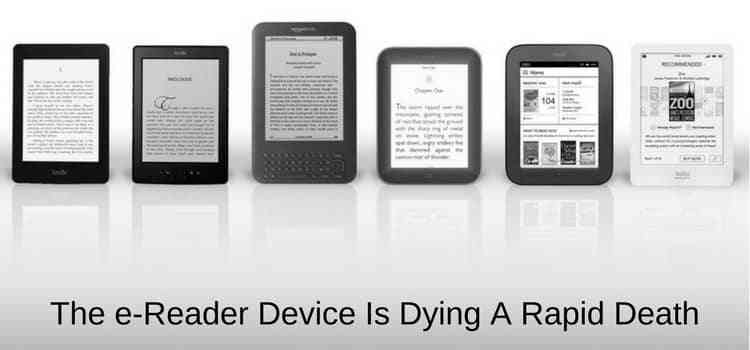
E-reader device sales are falling rapidly.
Devices such as Kindle e-readers, Nook, and Kobo are all suffering from a rapid drop-off in sales.
Yet, readers are still buying and reading ebooks.
So, what is going on here with ebook readers and, in particular, Kindle sales?
The Kindle device is in decline
First, in a report on The Demographics of Device Ownership in the US, Pew Research offers the following summary of reading device ownership.
The popularity of e-readers declines
Some 19% of adults report owning an e-reader – a handheld device such as a Kindle or Nook primarily used for reading e-books. This is a sizable drop from early 2014 when 32% of adults owned this type of device. Ownership of e-readers is somewhat more common among women (22%) than men (15%).
Data from Statista shows the decline in e-reader sales in more detail:
Shipments of e-book readers worldwide from 2008 to 2016 (in million units)
This statistic shows the number of e-book reader shipments worldwide from 2008 to 2012 and also offers a forecast until 2016. During 2009, around 3.8 million e-readers were sold worldwide.
In the United States, the revenue from e-books was 158 million U.S. dollars in 2008. Back in 2010, Amazon’s Kindle accounted for 62.8 percent of all e-reader shipments worldwide.
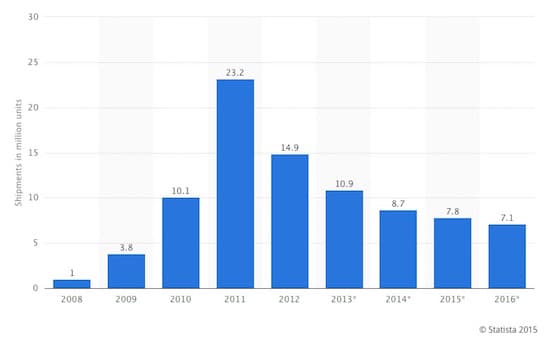
One of the main problems is that devices have failed to develop in any significant technical form since their introduction in 2008.
If you own a Kindle from 2009, you will know that it is almost the same as the current model. In fact, I believe my old 2nd gen Kindle is better, as it came with an audio connector, which was removed from later models.
Waterstones decided to stop Kindle sales. Managing director James Daunt says: ‘Ereader sales continue to be pitiful, so we are taking the display space back.’
E-reader device sales update
Do people still use Kindles? An update by Statista shows the continual decline of e-reader device sales for the period 2018 through 2025.
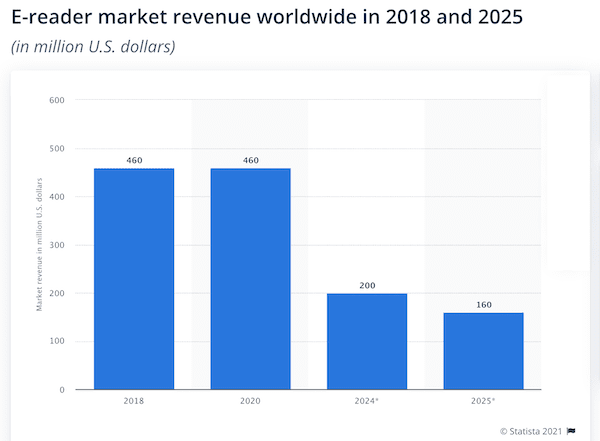

The declining trend of e-reader device sales is clearly continuing for Kindles and similar devices.
A phone or tablet is the new e-reader
If e-reader device sales are in free fall or in their death throes, how are people reading ebooks?
Again, from Pew, the data tells the story. Smartphones and tablets are the choices of ebook readers.
Cellphones are near saturation levels for some groups
Fully 92% of American adults own a cellphone, which is similar to the 90% of the public who reported owning these mobile devices in 2014.
Although cellphones are common today, the share of adults who own one has risen substantially since 2004, when 65% of Americans owned a mobile phone.
Close to half of all Americans own a tablet.
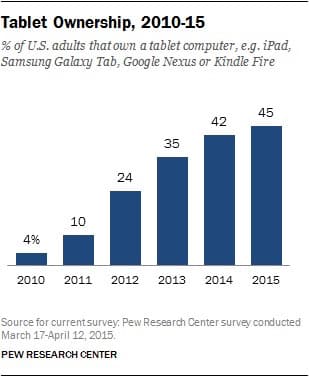
The share of Americans who own a tablet computer has risen tenfold since 2010. Today, 45% of U.S. adults own a tablet – a substantial increase since Pew Research Center began measuring tablet ownership in 2010.
Then, only 4% of adults in the U.S. were tablet owners. Ownership, however, is statistically the same as it was in 2014.
More recent tablet ownership statistics show that the worldwide trend continues.
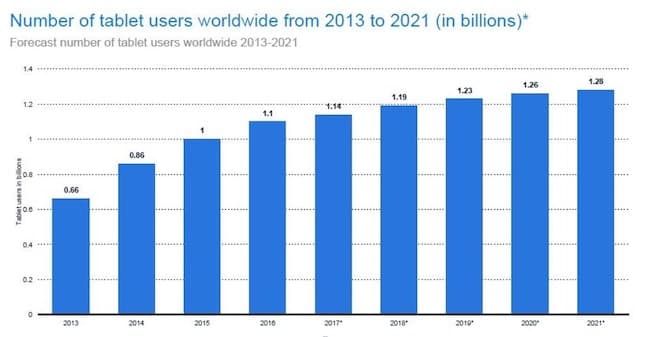
One of the reasons that tablets could be more popular than e-readers is color.
Most e-readers render in black and white, which is unappealing compared to tablets and smartphones that deliver high-quality color images.
If ebook readers are moving more and more towards reading ebooks on smartphones and tablets, what does this mean for self-publishing authors?
The most important consideration now is readability.
Reading on a smartphone using a reading app is not the same as on a dedicated e-reader or even a tablet.
With a much smaller screen area, thought must be given to far better ebook formatting, especially regarding font sizes.
Amazon Kindle Direct Publishing (KDP) accepts almost any font size in a Word document to be published as Kindle ebooks.
But titles and chapter headings of 24pt or more will look huge on a smartphone screen and distract badly from readability.
In the past, checking a new ebook on a Kindle or iPad using a reading app such as the Kindle App or iBooks was sufficient.
However, with the change in the reading market and how people read books, it will be essential to check any new ebook on a smartphone before publication.
Ebooks continue to be popular
The e-reader may be dying as Kindle sales by year are forecast to continue falling, but this is certainly not true for ebooks.
Again, from Statista, here is its rosy outlook for ebook sales revenue.
Revenue from e-book sales in the United States from 2008 to 2018 (in billion U.S. dollars)
The timeline presents data on ebook sales revenue generated in the United States from 2008 to 2013, as well as a forecast until 2018.
PwC expects the revenue will grow from 2.31 billion in 2011 to 8.69 billion in 2018.
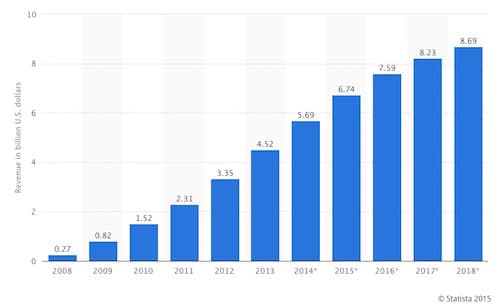
Update: Ebook consumption continued to grow in 2019, with over 335 million copies sold.

Here are some more interesting statistics about ebooks. Take note of the number of illegal downloads. It seems ebook piracy is not slowing down.
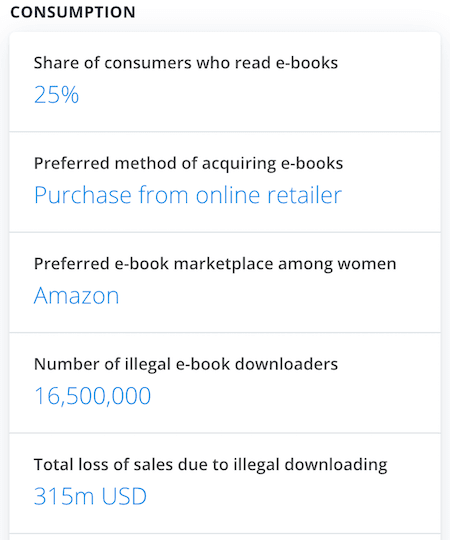
More change
And then, along comes the audiobook.
Another nail in the coffin of the sales of Kindle e-readers, Barnes & Noble Nook, Kobo, and Onyx Boox devices is the growing popularity of audiobooks.
This is no surprise because the fact fits with the logic that device buyers see no reason to buy specialized devices when one will do most tasks, even if the battery life is not as good as a dedicated e-reader.
In most cases, it is the smartphone that is leading the way. It is clearly the case with audiobooks, as the graph below from Statista shows.
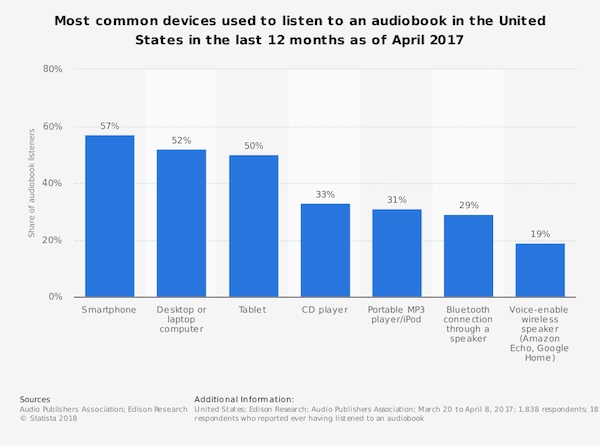
While print books are still leading the way, it is well worth noting that both print book and ebook consumption have remained flat over recent years.
In fact, there has been a slight decline in ebook reading, contrary to earlier economic forecasts.
However, these statistics may not take Amazon Prime and Kindle Unlimited ebook subscription reading into account.
However, audiobook consumption is notable because it is the one book format that is rising steadily.
Currently, one in five U.S. readers listens to audiobooks. The trend started in 2015, and there seems to be no reason why it will not continue to grow.

Adapt to change
If you are self-publishing ebooks, take care to accommodate your readers and give them a much better reading experience, no matter what device they use to read your ebooks.
Check and make the necessary formatting changes to your ebooks to ensure they are reader-friendly on smartphones.
You can check how your ebooks will look on smartphones and tablets before you publish to make sure your readers get a quality small format read.
Doing this check is especially important if you have included images in your ebook.
Are all your ebooks smartphone ready?
If they are, your next consideration should be audiobooks.
Producing high-quality audio is not as easy as publishing an ebook. But to get you thinking, you can read more information about how to publish an audiobook here.
It is no surprise that the dedicated e-reading device is dying.
Sure, many readers still love their Amazon Kindle Paperwhite or Kindle Oasis and the longer battery life. However, the number of new e-reader buyers is declining.
Smartphones are and will continue to be the most used device for reading ebooks and listening to audiobooks. It’s a two-in-one loser for dedicated devices.
For self-publishing authors, the future is clear.
Publish in all three formats to give your books the best chance of being read.
Give readers the choice of versions so they can buy your book in the format they prefer.
Update
Goodereader reports that the Amazon Kindle is in a state of decline due to internal issues at Amazon.
Quality and control of Kindle firmware development are at an all-time low. Many of the top executives at Amazon, who were in charge of software and hardware, quit the company or retired. A new generation of talent is at the top ranks, and many long-term Kindle developers were also laid off last year when Amazon fired thousands of workers. This is likely because Alexa, Kindle, and Fire tablets were losing 5 billion dollars per year and did not have any end in sight for making them profitable.
It is sad to see the Kindle, which used to have deadly hardware and an intuitive software experience, fall so fast in the eyes of its customers.
Related reading: What Are The Most Popular Devices For Reading Ebooks Today?



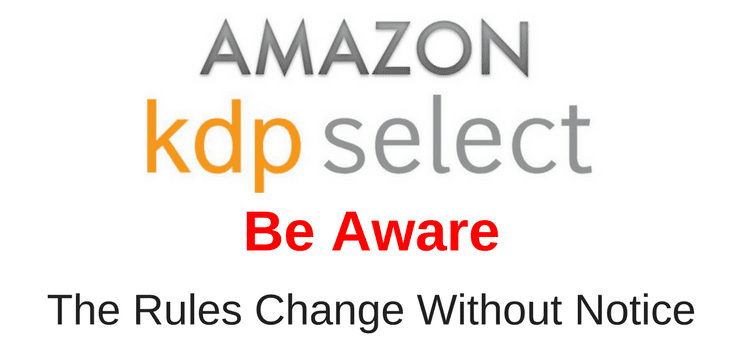
Thanks so much Derek, I am currently finalising my wife’s first book for KDP and was just comparing Tablet and E-reader previews.
I was concerned whether I should major on E-reader regarding formatting tradeoffs, I hadn’t even thought about phones.
Google, of course, is my friend and your friendly site was the first response I looked at, and I’m very glad I did.
Thanks again!
Yes, definitely concentrate your efforts on Phones and tablets, Mike.
Hello,
The statista graph you show is on eBook popularity is outdated. Updated information has had eBook sales peaking in 2013 at 242 million units sold.
Great article otherwise!
Subjective but not anything to take seriously.
This article is like comparing the sales of a Freewrite typewriter to a MacBook pro, but not accounting for people who are authors. One is for a dedicated audience and the other mainstream, multi-use tool. There will always be a niche to fill.
E-readers don’t need to be mainstream and, as long as they provide a distraction-free, battery-saving, reflection-free, eye-soothing experience, they’ll always sell to actual readers.
There are so many things wrong with your article. Sales worldwide have dropped due to Covid and supply on electronics across the World. Lots of folks at this point, almost half of Americans, already own an e-reader, so that is another thing that is affecting the sales. Also, the e-readers have dramatically changed. For example, 5 LED supported screens to 21 LEDs in 3 years on some models, waterproofing is common, Bluetooth, wireless charging, etc. Lots of new models coming out this year.
Today, many of us read on screens all the time, so it’s almost natural to look for an e:reader.
As the cost of paper books goes through the roof, why not get a subscription or a digital library card and read books virtually for free?
Exactly. We should be celebrating that there isn’t a cycle of planned obsolescence we see with these devices at least. If there were no new device releases or if people’s previous devices were working just fine, there would be no need to buy more. There are also plenty that get bought and sold on the second hand market including devices that are a decade old and still function well enough for basic reading use.
Oh no. I love my Kindle. Use it every day.
Of course ereader devices are on decline, for one simple reason; they suck! The experience is not even 25% as good as phone or tablet or physical book. And for a crappy device with awefull screen resolution, like 2020 Kindle Paperwhite and near impossible navigation, it is no wonder nobody wand to foreknowledge out $200-$500 for a device that’s not worth $50.
It really doesn’t seem like you actually know anything about ereaders at all.
Firstly, there’s no 2020 Kindle Paperwhite. Indeed, there were no kindles at all released in 2020. There’s a 2021, and a 2018 Paperwhite which have excellent 300dpi screen resolution. 6-7” ereaders also are much less than the price you’re claiming.
The 2018 6” Paperwhite was sold as certified refurb on Woot recently for $70, and when it was sold as new frequently would go on sale on Amazon for $80-90. The 2021 6.8” Paperwhite is $140 retail (the kids edition went on sale recently for $119).The 6” Kobo Clara retails for $119.99 and has gone on sale for <$100 (certified refurb can be had for $90). The 7” Libra 2 is sold for $179.99. It’s only the 8” devices that go above $200 and still below $300. Pocketbooks have slightly higher price points, but still nowhere near what you’re claiming.
The only devices that reach $4-500 range are specialist 10”+ eink note-takers like the Kobo Elipsa, Boyue Likebook P10W, Boox Note Air2/Note 5, Supernote A5X etc.
Secondly, Kindles and other ereaders have a much easier navigation than an android tablet. They’re not complex devices and there are different brands which offer different UIs depending on preference.
Thirdly, it is not a universal truth that the reading experience is worse than a tablet or physical book. Most ereaders are lighter than physical books and tablets, with some 7-8” models are designed with a handle which many find ergonomic to hold. If someone simultaneously likes to read several books at a time, then it makes even more sense. The less reflective screen means that, unlike a tablet, you’re able to read without any kind of backlight flashing directly into your eyes, and are able to read in direct sunlight (not something that can be done remotely comfortably on a phone or tablet).
Interesting to see such hubris and book-snobbery here. My mostly rather slim novels net me about £9000 a year from KOLL & KU. It’s not much, especially considered individually, but I’m pretty glad of it, I can tell you. You have to do what you can in the environment you find. No sense going all haughty about it. Amazon won’t care. As to what gadget folk are reading my stuff on: as long as they continue to do so I don’t give a monkey’s frankly. I’m not hawking my stuff around purblind paperback publishers with their silly negative comments at my time of life. Had all that.
Its not a decline in interest but devices are only coming out new every 2-3 years instead of every year and ereaders now have more storage for more books. People do not need to upgrade as often so the interest is still there. Also many people do not understand the benefits. If they did new people will come into the ereader market. So much easier to read and you tend to read more! I went from reading 1 or 2 books a year to 2 to 3 a month.
This is also true. I have no interest in the Oasis, but there has not been an upgraded version of the Paperwhite or Voyage lately. Not having new releases of some of the other models should show less purchases. This may shift when new e-reader devices come out and people choose to upgrade.
For the people that prefer printed books over an E-reader, (which is provocative, and ignorantly annoying) because the feel of paper: The book is not the important part; the book is a delivery system. The important part is the story and the talent.
I could NOT agree more. I like both print and ebook readers, but increasingly have to moved to ebooks because print publishers, to save money, too often use very tiny fonts. I’m not reading on “large print” when I use my Kindle Whitepaper of iPad, but I almost always bump up the text size a notch. And yes, by the way, when I got into ebook reading I quickly DID understand that it was all about the story, not the way in which it was presented.
Not necessarily. The book itself can be a tactile and aesthetic pleasure. It’s not a crime! BTW I do read on Kindle(and occasionally, on iPhone too, for portability, legibility and general convenience.
The sales data you published does not indicate a “rapid death” of real e-book reading devices, but leveling (granted, with the plateau being at some 30% of the peak in 2011). The sky is not falling. Novelty has worn off, and only people who actually read a lot now buy Kindles and similar devices. But such people are not going away.
As for technological improvements, there is not all that much to improve, after introducing frontlight and bringing back audio (to Oasis). Heck, you can even read it in a bathtub! Color would help, but, apparently, the early promise of Mirasol and Liquavista technologies have not panned out. If they did, this would increase the appeal of “color Kindles” only slightly – they would be better for reading magazines, comics, and textbooks, but would still not appeal to Twitter, Angry Birds, and Pokemon Go addicts.
A decline in eReader sales doesn’t mean people don’t regularly use eInk eReaders. It’s just not a device you have to buy every year. And there are a lot of used ones you can buy cheaply that won’t show up in the statistics. Tablet sales have also been dropping steadily for three (or so) years. People realized they didn’t have to replace them every year.
When you have a monopoly (IE Amazon) you have no reason to innovate. So that means nobody has a reason to upgrade. With no reason to upgrade, only new readers are buying them and those who have had their current ones finally die.
Personally, I have a Kindle Paperwhite, but am planning on buying a Kobo instead soon as I can. Probably will keep the Paperwhite for a few things, but the Kobo has been innovating by including water resistance, etc… (but not enough to force mass upgrades) and I’m tired of the Amazon monopoly. I do not like DRM either, so most books which have DRM have very little value to me. I won’t spend much more than $2 for a book with DRM. And I will do my best to rid myself of that DRM as well. Amazon does a terrible job in telling users which books have DRM and those that don’t. Kobo clearly labels theirs, while Nook doesn’t even mention it.
I am blind and use the text to speech facility on my Kindle to read ebooks. You mention audio having been removed from new Kindles. By this do you mean that the text to speech facility is no longer available? If so this is a retrograde move by Amazon. I own 2 Kindles both of which have the text to speech facility, the last one is just over 2 years old. Kevin
Unfortunately the E-reader manufacturers did not build in an obsolete button with their products and as someone else has commented… they last for years.. Mine is 6 years old and still going strong. There are no viable or convincing upgrades so those who bought one are not going to buy another one soon. I get the new generation is moving to smartphones to read a book which is diabolical.. I have seen it and would not touch.. I don’t want a tablet either and certainly will stick with print and Kobo.. I do also think that the manufacturers are being lazy on the marketing front. There are many areas of the world that are opening up to the Internet gradually and this is where there will be a potential for growth as E-readers offer access to books on a much more economical scale. Not only that but with the cost of text books in schools and universities I am surprised that they have not opened up that stream of revenue.
I’m a diehard print girl which makes me an anomaly in the ‘all things tech’ world. Very doubtful I’ll jump on the E-reader train any time soon. There’s no reading experience comparable to that print lends – the touch of paper!
You could wrap an e-reader in paper so you could still feel and smell the paper while you read!
oh, I just fell in love with you, thank you for the laugh! Us library user types are very familiar with the enchanting feel of paper pages decorated with booger (I hope nothing worse) smears from a previous borrower on the printed text or margins. Maybe I’m wrong…I suppose that sometimes they could be food stains. If it’s KFC, it’s ok!
While there is a discussion to be had on whether or not most people need a dedicated book reading device, I hardly think that the eReader is going to be going anywhere. I think that the advent of the iPhone and peoples’ desire to upgrade every one or two years have given the market unrealistic expectations for sales. You see this with the doomsayers for tablets as well.
There’s a part of the market that will always want an eReader, just like there’s part of the market that will always prefer print books. Unfortunately for Amazon, the Kindle is a pretty reliable device, as are other eReaders. Mine is between 3 to 4 years old and barring some sort of revolutionary upgrade, I probably won’t be upgrading it for a while. The same is pretty much true for everyone I know. Granted, this is all anecdotal, so take it for what it is. I just think that there will always be a market for a device whose only purpose is to read books on, that takes advantage of the eInk display.
Though, now that I think about it, I am from a generation that grew up reading print, so perhaps as we go forward and more readers who grew up with a digital screen as their primary means of consuming text will think that the eInk just looks weird and are more comfortable with a tablet or phone display. Perhaps I will shake my stick at the sky and cry out against “kids these days”. Not there yet though.
I grew up reading print and prefer print and paradoxically, I can get an experience that is CLOSER to reading print on a digital screen vs. an ereader. A lot of the ebooks I find online are scans of print books, complete with the yellowing of an aged paperback that just wouldn’t be there on a greyscale kindle. I prefer that over eInk. To me, it just looks and feels more like a book than anything on a kindle, eInk or not.
I have found that e-readers as a whole are unreliable. I had a Nook reader, brand new, bought from the company. It lasted a year, and I replaced it when it died. The Nook reader that I replaced it with had a similar life span. The next e-reading device I bought was a small tablet. I installed a Barnes and Nobel reading app on it, and that lasted perhaps six months, before it began to malfunction.
I had many, many books in my e-reader library. This was all very lovely, however, I could not sort those books out, in order to find one that I wanted to look at again, or to look up a certain author who had impressed me with her writing. I know a number of people, who a few years ago were very enthusiastic about their e-readers, and now insist that they will not read anything but hard and soft cover books. If my experience was like theirs, I can easily see why.
I don’t think buying two Nooks and having them both die is evidence that all e-readers are unreliable.
There are 5 kindles in this household that have been purchased since the first few versions of the Kindle.
The Oasis 3 is a Christmas present, and thus has been tested working and is now wrapped.
The Kindle Voyage was purchased on release in 2014 -and still works as new with slightly reduced battery.
The first generation of the paperwhite was given to me on that upgrade, and was purchased within a year of release so 2012-2013, this still works as new but with degraded battery life (It needs charging roughly every 15 – 20 hours)
The only kindle to fail was one of the first versions, and this was replaced immediately by Amazon, they even replace if slightly out of warranty.
As long as people would want to actually *read* in a park or on a beach, “electronic paper” devices are safe. Here “electronic paper” does not necessarily need to be e-Ink (electrophoretic) display, but several alternative technologies (electrowetting, interferometric) fizzled.
As soon as somebody produces reliable *reflective* full-color 300dpi *fast* display, e-readers and tablets (or phablets) will merge. Such technology, though, is still not on the horizon.
What I find interesting is there is a Casio watch (CASIO WSD-F20A) out there that seems to merge a e-ink screen with a typical LCD screen (can’t find actual specs but the battery life seems to imply this). I’m wondering if this is where the future may go. It turns on the LCD screen for color books/comics and switchs to a eink display for standard books and it’s all in one tablet/device?
When apple crushed it’s reader on the IPad it killed my collection. No sign of them bringing it back; shows the downside of Apple specifically and the level or protectionism in the industry.
Yes, John. Apple is becoming quite adept at taking things away, but charging more for the loss of functionality. Removing USB ports from the new Macbook Pro is its latest take away, for a higher price.
They did that a few years back with the SCSI connection, which they refused to support any longer, leaving me with useless peripherals. But what’s the option?
Can you explain what you mean when you say “when Apple crushed its reader on the iPad and it killed my collection”? Neither has happened to me. I still use iBooks on my iPad and have complete access to my collection. One of us is missing something regarding your comment.
In 2015 Amazon was set to pay self-published authors as little as $0.006 per page read.
I’ve pulled all my 90 books out of this scam.
One of my books has a 109,000 word count – New Times Roman font 12 no spacing, 312 pages.
If all were read I would receive 312 x $0.006 = $1.87(2).
A cash sale would (did) bring almost twice as much.
Amazon is cashing in with their ‘free reads’ (for $9.99). Ebooks that the readers are not allowed to keep longer than a calender month.
So, authors have not only a greedy and stingy, corrupt publisher to contend with, they have all these numb-nut readers who in my opinion are’t serious readers at all but Yo-yo’s with an identity problem looking to find themselves by obtaining as many titles as possible, — a well-read pleb.
At $0.006 per page, 99.5% of self-published authors are being overpaid. Self-published authors are often so full of themselves. They just can’t understand why people don’t flock to their books. Because they suck! You have no talent! If you were a real writer you wouldn’t worry at all about getting paid for your 109,000 words of unreadable crap. You’d worry about perfecting your craft until you had people who know good writing banging on your door to see what you’ve written..
As both an author and a reader, I find a lot of self-published authors who have excellent talent, and a lot of “established” authors who suck out loud. “Talent” has little to do with why someone gets published or not. It’s about a multitude of factors, many of which make no sense.
Gee. I have no problem. I bought a Grand Cherokee with the last book. Oh well. You keep jumping through the hoops. It will pay off. Sure we have to understand the audience, marketing and the rest as well as write the book but it does pay off in the end for many of us. My mentor makes 10000+ a month. That’s my goal. And I can’t tell you how many in KU have told me, ‘I read the book then bought it to keep’ so I got paid twice.
But the market is versatile. You do it your way.
The “greedy, stingy and corrupt publisher” (BTW, Amazon is *not* the publisher of KDP works – you are) provided you with a “scam program’ which you are free to opt in or out of as you please, in order to make you ‘masterpieces’ available to readers who want quick, throw-away reads (you know, ‘beach reads’, ‘airport books’). If you think people will buy your book for $9.99 providing you with close to $7 of royalties, by all means, go ahead and pull out of KOLL program.